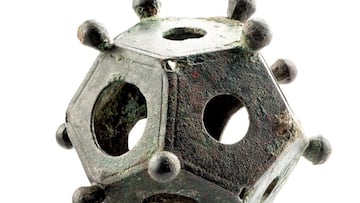Strange Roman artifact found in UK: mystery about its use
This twelve-sided polygon of Roman origin and the size of a golf ball fuels the imagination of historians around the world baffled by possible use.

In Kafka’s short story “The Concerns of a Family Man”, the protagonist tells us about an object called “Odradek” that appears one day in his house and no one knows exactly what it is or what it does. No matter how much one observes it, one cannot attribute a form or use to it. It is a kind of starry reel covered with pieces of colored thread knotted together. From its center emerges a stick to which another one is fixed at right angles and which, together with a lateral extension, help it stand on two legs.
No one knows if Odradek is broken or works perfectly, it seems like a useless but complete object. It should have, but does not convey, any reason for being. This strange figure seems to worry the father of the family. How can we value something whose essence we do not know? Where does Odradek begin and end? “It doesn’t seem to hurt anyone; but the idea that it could survive me is almost painful to me.”
Three centuries of mystery
Human historians, no matter how hard they try to avoid them, occasionally come across an abandoned Odradek at some archeological site. The last one in the city of Norton Disney (England), in the shape of a twelve-sided Roman polygon, or a dodecahedron. Odradek can take on numerous appearances, as long as he cannot be recognized. Since the first Roman dodecahedron was found in 1739, this unusual object has caused headaches for archaeologists and parents.
About the size of a golf ball, each of the faces has a circular hole in the middle, sometimes of different sizes each. More than 250 years have passed since this object was first found in the English city of Aston until last June when amateur English archaeologists found the 33rd dodecahedron on English soil. Although more than 100 of these curious objects have been found, no one has been able to determine what they were used for.
Press enquires from Talk Radio and a French magazine this afternoon, oh and Der Spiegel this morning. All a bit weird being international famous. Anyway we return to excavating Norton Disney's archaeology in early June with our partners @allenarchaeo . 13 tonne digger is ready! pic.twitter.com/mnE8e2uMju
— Norton Disney History + Archaeology Group (@ndhags) April 30, 2024
Of various sizes and textures
The dodecahedra found vary from an inch and a half to over 4 inches and all of them were built between the 2nd and 3rd centuries AD. They vary both in their size, in their texture, and in the material (stone or bronze), so many archaeologists rule out a mathematical use of it or to make astronomical predictions or to measure things, since the logical thing would then be for it to have standardized dimensions and weight.
It is believed that it was not a common object, but not excessively strange either. The fact that several of them have been found in tombs or in coin caches supports the hypothesis that they were objects of some value to Roman citizens. With this knowledge in hand, historians have looked for various “reasons for being” for the mysterious contraption, but none have managed to find an explanation convincing enough to be accepted by their colleagues.
Candlestick, dice, pipe gauge...
A candlestick, a type of dice, a gauge for water pipes, a cane to hold war banners, a device to place fingers and thread while sewing, a children’s toy, an amulet, a divination object... The attributes of the dodecahedron have been so many and so varied that one could almost divide the historiographic tradition based on this object: at first a military meaning was attributed to it, but this was rather due to a vision “war” of history.
Later, it was attributed a mathematical or predictive utility that, as we have said, also lost weight. Then it was decided to imbue it with a superstitious character or as a talisman, since, although they have been found throughout Europe, the vast majority were found in the ancient territories of Gaul, Germany and Britain.
Related stories
This entire area was occupied at that time by Celtic tribes, who usually made use of this type of amulets. Nowadays, many historians believe that it was used in the daily activities of Roman families. A video recently went viral on YouTube in which a user demonstrated how the dodecahedron could be used to sew a wool glove. It is true that Odradek was covered in colored threads...
A possible explanation could be found in Southeast Asia, where smaller versions of the dodecahedron made of gold were found. However, until some written or pictorial remains are found that explain what this curious artifact was used for, it seems that historians will have to resign themselves to continuing to play guessing games with this silent object .


Complete your personal details to comment